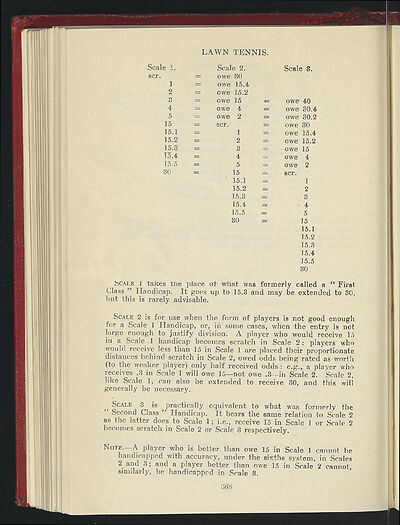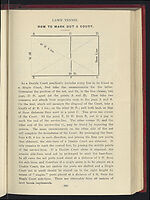1936-37
(390)
Download files
Complete book:
Individual page:
Thumbnail gallery: Grid view | List view

LAWN TENNIS.
I
Scale 1. Scale 2. Scale
B.
scr. — owe
30
1 = owe
15.4
2
= owe
15.2
3 = owe
15
owe 40
4
= owe
4
= owe 30.4
5 = owe
2
= owe
30.2
15
= scr. = owe
30
15.1 = 1
= owe
15.4
15.2 = 2
= owe
15.2
15.3 = 3
= owe 15
15.4
=
4
= owe 4
5.5 — 5
— owe 2
30 15
= scr.
15.1 =
I
15.2 = 2
15.3 = 3
15.4 = 4
15.5 —
5
30 = 15
I
5.1
15.2
15.3
15.4
15.5
30
bCALE 1
takes the place
of
what was formerly called a " First
Class " Handicap. It goes up
to 15.3
and may be extended to 30,
but this is rarely advisable.
S
CALE 2 is
for use when the form of players is not good enough
for a Scale I Handicap, or,
in
some cases, when the entry is not
large enough to justify division. A player who
wou
ld
rece
i
ve
15
in a Scale 1 handicap becomes scratch in Scale
2:
players who
would receive less than
15
in Scale 1 are placed their proportionate
distances behind scratch in Scale
2,
owed odds being rated as worth
(to the weaker player) only half received odds: e.g., a player who
receives
.3
in Scale i will owe
15
—not owe
.3
—in Scale 2. Scale
2,
like Scale 1, can also be extended to receive
30,
and this will
generally be necessary.
S
CALE
3
is practically equivalent to what was formerly the
" Second Class " Handicap. It bears the same relation to Scale
2
as the latter does to Scale 1; i.e., receive 15 in Scale I or Scale
2
becomes scratch in Scale
2
or Scale
3
respectively.
N
OTE.
—A player who ig better than owe 15 in Scale 1 cannot be
handicapped with accuracy, under the sixths system, in Scales
2
and
3;
and a player better than owe 15 in Scale 2 cannot,
similarly, be handicapped in Scale
3.
363
I
Scale 1. Scale 2. Scale
B.
scr. — owe
30
1 = owe
15.4
2
= owe
15.2
3 = owe
15
owe 40
4
= owe
4
= owe 30.4
5 = owe
2
= owe
30.2
15
= scr. = owe
30
15.1 = 1
= owe
15.4
15.2 = 2
= owe
15.2
15.3 = 3
= owe 15
15.4
=
4
= owe 4
5.5 — 5
— owe 2
30 15
= scr.
15.1 =
I
15.2 = 2
15.3 = 3
15.4 = 4
15.5 —
5
30 = 15
I
5.1
15.2
15.3
15.4
15.5
30
bCALE 1
takes the place
of
what was formerly called a " First
Class " Handicap. It goes up
to 15.3
and may be extended to 30,
but this is rarely advisable.
S
CALE 2 is
for use when the form of players is not good enough
for a Scale I Handicap, or,
in
some cases, when the entry is not
large enough to justify division. A player who
wou
ld
rece
i
ve
15
in a Scale 1 handicap becomes scratch in Scale
2:
players who
would receive less than
15
in Scale 1 are placed their proportionate
distances behind scratch in Scale
2,
owed odds being rated as worth
(to the weaker player) only half received odds: e.g., a player who
receives
.3
in Scale i will owe
15
—not owe
.3
—in Scale 2. Scale
2,
like Scale 1, can also be extended to receive
30,
and this will
generally be necessary.
S
CALE
3
is practically equivalent to what was formerly the
" Second Class " Handicap. It bears the same relation to Scale
2
as the latter does to Scale 1; i.e., receive 15 in Scale I or Scale
2
becomes scratch in Scale
2
or Scale
3
respectively.
N
OTE.
—A player who ig better than owe 15 in Scale 1 cannot be
handicapped with accuracy, under the sixths system, in Scales
2
and
3;
and a player better than owe 15 in Scale 2 cannot,
similarly, be handicapped in Scale
3.
363
Set display mode to:
![]() Universal Viewer |
Universal Viewer | ![]() Mirador |
Large image | Transcription
Mirador |
Large image | Transcription
| Games and sports in the army > 1936-37 > (390) |
|---|
| Permanent URL | https://digital.nls.uk/248723008 |
|---|
| Description | 'Games and Sports in the Army' was an annual publication produced by the British War Office between the 1930s and 1960s. This included the Second World War. It outlines the rules and regulations for games and sports played by members of the armed forces. It features names and photographs of team members, and examples of contemporary advertising. |
|---|---|
| Shelfmark | GWB.52 |

